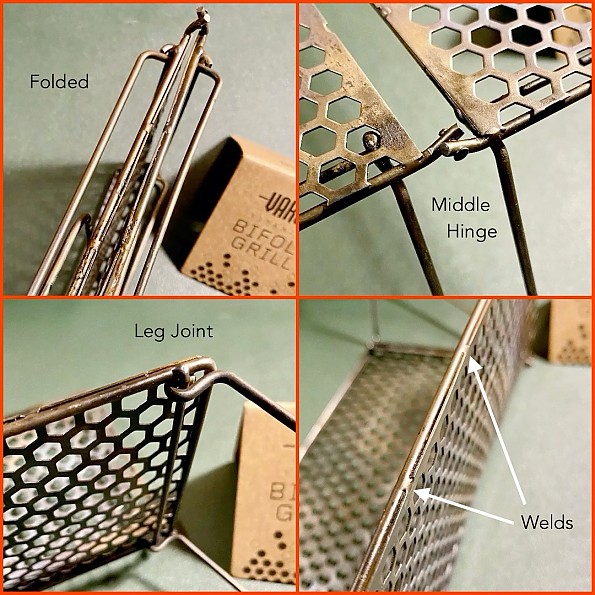Vargo Titanium BiFold Grill

Small and admirably compact, the Vargo Titanium BiFold Grill is designed for backpackers who want a lightweight grill option for backcountry use. A bit pricey and a little finicky to use, the 60-square-inch grill nevertheless serves its purpose well for solo or perhaps even light two-person use. It is recommended for those willing to put up with some minor annoyances for the sake of adding grill options to their wilderness cooking.
Pros
- lightweight (3.8 oz/ 107 g without the pouch)
- compact
- easily carried
- easily cleaned
- well-designed storage pouch
Cons
- a bit pricey
- low to the coals and a bit finicky to set up
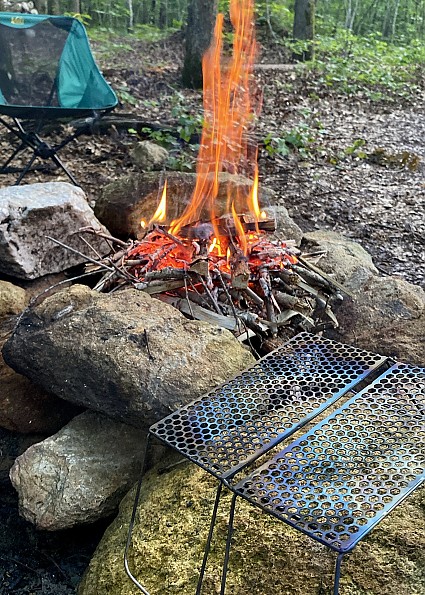 When it comes to food, I tend to go with whatever I’m craving on a given trip. That can be as simple as a dehydrated or freeze-dried meal in a pouch, or it can be as complicated as almost anything I might cook in my home kitchen. There are places I venture that allow campfires in established fire rings, ideally where it's possible to exercise LNT best practices for fire use (always check camping/wilderness regulations on fire use before leaving on a trip).
When it comes to food, I tend to go with whatever I’m craving on a given trip. That can be as simple as a dehydrated or freeze-dried meal in a pouch, or it can be as complicated as almost anything I might cook in my home kitchen. There are places I venture that allow campfires in established fire rings, ideally where it's possible to exercise LNT best practices for fire use (always check camping/wilderness regulations on fire use before leaving on a trip).
Inevitably, my most indulgent backcountry feasts all begin with a grill over a bed of coals: there is something that speaks to me about the allure of woodsmoke and embers in wilderness air and the rising scent of savory food wafting up from the sizzling grill. This is where something like the Vargo Titanium BiFold Grill comes into play.
Overview
Simply put, this is a compact, lightweight, titanium folding grill. According to Vargo, the Titanium BiFold grill provides 60 square inches of cooking space (7.5 x 8 in/ 19x20.3 cm)—this is true, provided one counts the gap between the two sides of the grill as part of the cooking area.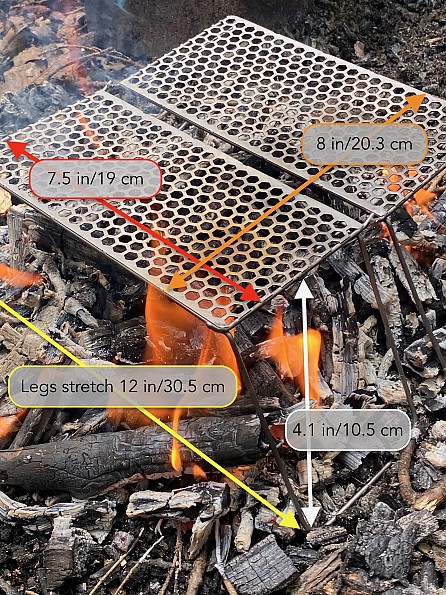
It sits 4.1/10.5 cm off the ground, spanning 12 in/30.5 cm at the bottom of the legs when fully opened and weighing in at a feathery 3.8 oz/ 107 g—add another 1.2 oz/ 35 g for the durable hook-and-loop closured pouch if you want to protect the grill and keep your gear clean from soot. Opening the grill requires one to just open the two halves of the grill, then extend the four legs. That’s it. Collapsing the grill is equally simple: one folds the legs under each half of the grill, then folds the two halves of the grill together.
Opening the grill requires one to just open the two halves of the grill, then extend the four legs. That’s it. Collapsing the grill is equally simple: one folds the legs under each half of the grill, then folds the two halves of the grill together.
This folded grill readily slides into the provided nylon pouch, a feat accomplished thanks to a tough, rubbery coating on the interior fabric of the pouch that allows the grill to slide in effortlessly despite its various protrusions. Once in, it is readily secured with the hook-and-loop fastener. Another perk of the rubbery coating is that it can be wiped out before storage if soot or food debris from the used grill has dirtied the interior of the pouch.
 Despite Vargo’s assertion, the Titanium BiFold Grill doesn’t quite have a “fold-flat design.” To accommodate the folds of the grill, the actual folded thickness of the grill is 1.1 in/ 2.9 cm. Nevertheless, as Vargo claims, “packing and carrying it is easy and lightweight.”
Despite Vargo’s assertion, the Titanium BiFold Grill doesn’t quite have a “fold-flat design.” To accommodate the folds of the grill, the actual folded thickness of the grill is 1.1 in/ 2.9 cm. Nevertheless, as Vargo claims, “packing and carrying it is easy and lightweight.”
Design
Backpacking grills come in all sorts of designs. Some are single-piece designs, some fold, some require assembly. At their most basic, they might be simply two bars that can perch between rocks (like the Purcell Packers Grill), or a perimeter frame that supports a metal mesh (like Expedition Research’s The Original Bushcraft Grill). Compared to other such designs, the Titanium BiFold Grill is more complicated and may appear more fragile with its folding design. Yet the titanium seems to be of excellent quality, and the metal seems resilient when put to use.
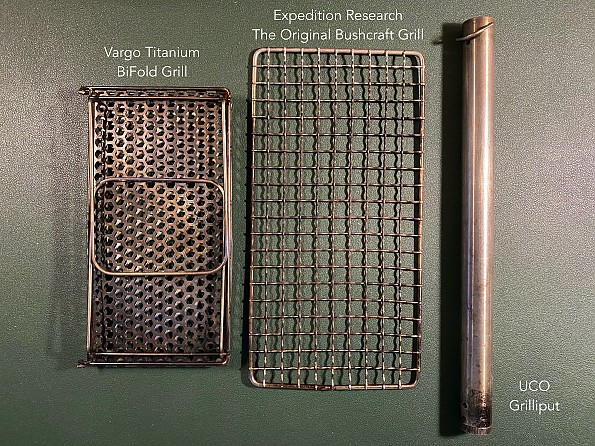 While more complicated than some grills, the Titanium BiFold Grill has an advantage over others (such as the UCO Grilliput) in that it requires no assembly, just a little unfolding. The nesting steel tubes and grill bars of the Grilliput are ingenious, but years ago I lost one of the grill bars to the darkness of night. The design of the Titanium BiFold Grill eliminates any potential putting-it-together problem while also saving 14.7 oz/ 418 g of weight over the Grilliput!
While more complicated than some grills, the Titanium BiFold Grill has an advantage over others (such as the UCO Grilliput) in that it requires no assembly, just a little unfolding. The nesting steel tubes and grill bars of the Grilliput are ingenious, but years ago I lost one of the grill bars to the darkness of night. The design of the Titanium BiFold Grill eliminates any potential putting-it-together problem while also saving 14.7 oz/ 418 g of weight over the Grilliput!
The grill surface itself is made of .03 in/.75 mm thick hexagonal titanium mesh. Don’t let that thinness alarm you: thin titanium can be quite strong, and here strength and lack of give are achieved by the forty or so places around the wire frame where the grill surface is welded to the frame. The grill legs may flex slightly if heavy pots are placed atop it, but they are sturdy. Vargo notes in its website product Q&A that they “recommend not putting anything on the grill over 5lb,” which is the equivalent of about 9.59 cups/ 2.27 L of water.
If there is a weak spot in the grill, it may be the pinned middle hinges that allow the two sides of the grill to fold together for storage. A tiny pin secures each hinge, flared on each end to prevent the pin from slipping out of the holes in the grill halves (see image, below). To be clear, I have had zero issues with these hinges, and I suppose one could simply run a piece of wire through the hinge if the pin were ever to fall out after much use. These joints, though, appear to be more vulnerable to stress over time than the grill’s the leg joints or welds.
So light and seemingly delicate a design has provoked plenty of questions about durability. The topic of potential warping appeared a few times on Vargo’s “Questions & Answers” tab on the grill’s product page.
In one reply, Vargo noted that they “do not recommend that you use the grill in extreme heat. A campfire small enough for the grill to fit overtop will not result in any damage.” In response to another question about warping on the Vargo site, the company replied, “We tested the grill ourselves over a campfire and had no warping issues. Like all of our products we offer a 100% guarantee so if you ever had an issue we would be happy to issue a refund or replace the product.”
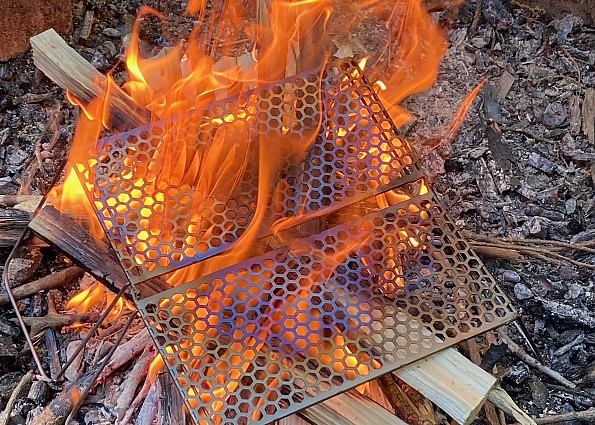 I tested the grill in open flames when it was new, and while the usual titanium rainbow-hued heat tint appeared, there was only negligible warping of the hexagonal mesh. This slight warping in no way affected the utility of the grill, and I went on to use it countless times as a pot stand or as a grill over fires and beds of coals. So, though I did find the grill warped a bit in intense heat, it certainly was not an issue, and therefore my own experience with the grill supports Vargo’s assertions about the heat of a properly sized cooking fire not being a problem for the grill.
I tested the grill in open flames when it was new, and while the usual titanium rainbow-hued heat tint appeared, there was only negligible warping of the hexagonal mesh. This slight warping in no way affected the utility of the grill, and I went on to use it countless times as a pot stand or as a grill over fires and beds of coals. So, though I did find the grill warped a bit in intense heat, it certainly was not an issue, and therefore my own experience with the grill supports Vargo’s assertions about the heat of a properly sized cooking fire not being a problem for the grill.
Setup
As I noted previously, the setup is simple. Sort of. In theory, all one has to do is open the two halves of the grill and then extend the legs and place it over the fire.
For all the thought that evidently went into the Titanium BiFold Grill and pouch’s design, I discovered one real issue: placement over coals is tricky.
Let me explain by way of comparison with the grills I mentioned above. Expedition Research’s The Original Bushcraft Grill can be dropped onto two logs or stones across a bed of coals for use. If the placement goes awry, a poke from a stick can safely position the grill for use. UCO’s Grilliput stands on four steel legs, which are essentially threaded steel bars. The grill can be placed over a fire from the side and easily leveled by poking down this or that leg. In both cases, the user can stay well clear of the flames or coals.
However, in order to place the Titanium BiFold Grill over a fire, one must simultaneously keep all four legs spread open while keeping the two sides of the grill from folding in on themselves. That means managing five different points where the grill folds (the four legs and the center of grill), all of which move freely, none of them locking, as one attempts to spread the grill across hot flames or coals.
The video below demonstrates the setup, then shows the grill in place over hot coals, which suggests the challenge of placing the grill with its floppy legs when it perches just a few inches about the heat source.
The setup problem arises because of the grill’s folding nature. The natural tendency of the legs is to dangle directly beneath the grill, not spread out to the sides as they must be in order for the grill to be stable. An errant placement of the grill could cause the grill’s legs to fold beneath it or, if not all of the legs stay open, the grill might tilt like a ramp.
The height of this grill is also quite low (4.1 in/10.5 cm), especially when compared to other grills with legs. Doubtless, this is because such a lightweight grill is intended for use with small fires, as Vargo notes. However, the relatively low height of the grill also means one has less wiggle room to play with in terms of grill height about the coals.
Most beds of coals are not perfectly level, and perching the grill’s legs atop stones or logs is also tricky, further complicated by the four flat wire “feet” of the grill. If the surfaces on which I was placing the grill’s feet were at all irregular, instability could be introduced to the setup. An individual tilted leg can also mean that the grill might try to fold in on itself in the middle, too, creating more of a “V” cleft between the grill sections than a flat platform. The foldability of the grill also means that adjusting it is a much more delicate and challenging a task than adjusting other styles of grills. That little game worked best with a couple of sticks and some patience.
Locking legs would help greatly. Given the springy nature of the titanium legs, this is something Vargo may be able to address with some sort of friction lock that could keep the legs locked open for easier placement. As it is, I generally find myself trying to hold the legs out and quickly dropping/placing the grill on a bed of coals, then knocking the legs out with sticks until I manage to get the grill level. Yes, I did try building a fire beneath the grill, but its low height makes building a decent bed of coals difficult if one chooses to go this route.
Raking coals under the grill is an option, but the grill is so lightweight that it is easy to knock it over when shoving coals under it. Indeed, the lightness of the grill is something of which to be cognizant during use. It is perfectly serviceable, but one needs to adjust one's actions to take this lightness into consideration when poking food, turning food over, or other cooking maneuvers. The Titanium BiFold Grill obviously does not have that reassuring stability and mass of larger steel or iron grills.
Before moving on to assessing whether or not this is a fatal flaw in the grill's design, it might be useful to share a chart here to summarize some of the pros and cons I've mentioned about the Vargo BiFold and other grills.
Is this finickiness of setup a dealbreaker?
No, it’s more of an annoying idiosyncrasy of the design. The Titanium BiFold Grill remains durable, lightweight, and compact, and once set up properly, the grill works beautifully. I found the titanium mesh resisted food sticking to it and also cleaned up easily after use. Though I once lost a piece of asparagus to the gap between the grills, the grill surface itself was very usable.  I could place a pot or a pan on it and bake bannock, while grilling a couple of steaks, for instance.
I could place a pot or a pan on it and bake bannock, while grilling a couple of steaks, for instance.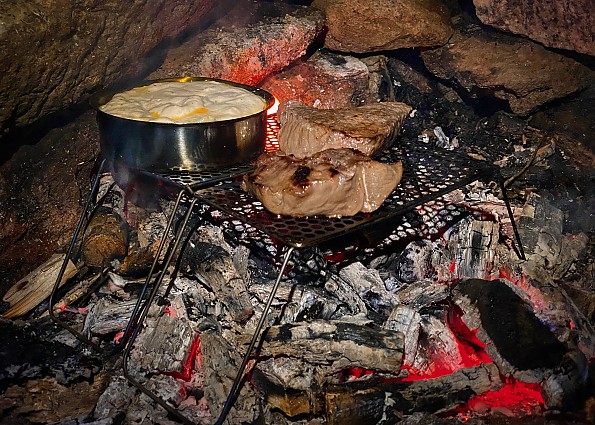 I discovered the grill can be used as a makeshift plate, too, to keep food off of the ground.
I discovered the grill can be used as a makeshift plate, too, to keep food off of the ground.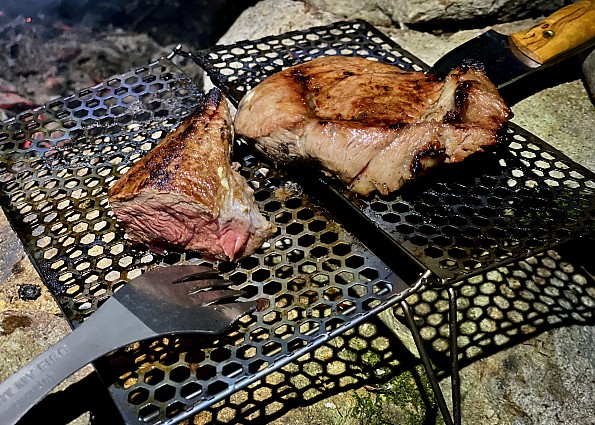 I could scramble eggs in a pan while grilling a few slices of Spam, one of my only-when-camping guilty pleasures.
I could scramble eggs in a pan while grilling a few slices of Spam, one of my only-when-camping guilty pleasures.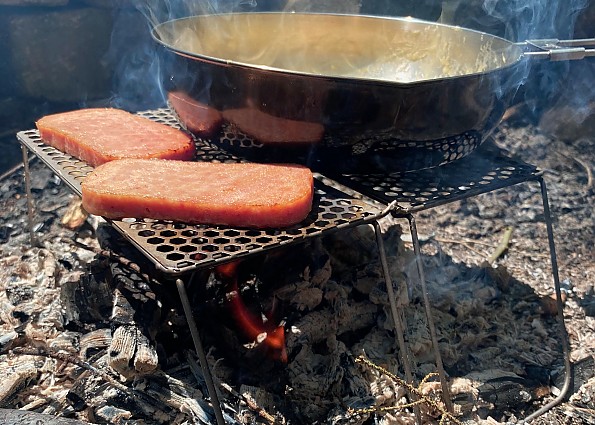 Or, first thing in the morning or after a meal, I could put on a kettle of water to boil for tea or coffee.
Or, first thing in the morning or after a meal, I could put on a kettle of water to boil for tea or coffee.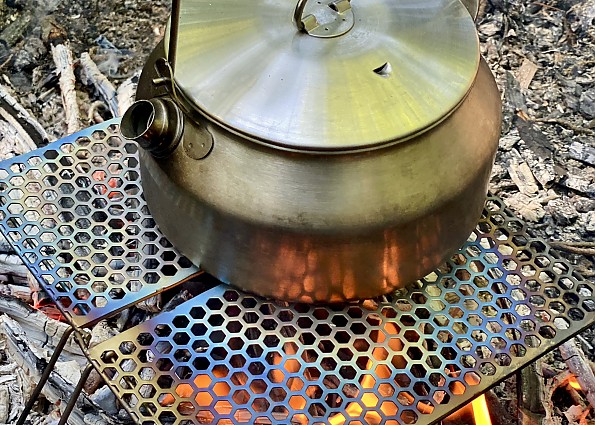 Due to Covid-19 restrictions, I didn’t manage to get anywhere that I could catch and cook fish in the wild, but the grill would certainly accommodate any fish that was smaller than or the same size as the grill or which one could cut into smaller fillets or steaks.
Due to Covid-19 restrictions, I didn’t manage to get anywhere that I could catch and cook fish in the wild, but the grill would certainly accommodate any fish that was smaller than or the same size as the grill or which one could cut into smaller fillets or steaks.
I generally found the size of the grill to be perfect for one person’s needs—maybe two, depending on the food. For all that Vargo’s claim of 60 square inches of cooking surface may sound impressive, just keep in mind that that is a good bit smaller than a letter-sized sheet of paper.
Conclusions
Overall, the Vargo Titanium BiFold Grill is a quality, lightweight option for anyone who wishes to add grilling to his or her backcountry cooking options, or—more simply, for any seeking a portable flat surface to support a pot or pan over a fire. Sturdy for its size and weight (once placed correctly!), this compact and easy-to-clean grill can be readily tucked in a pack without much of a space or weight penalty. It is not without its drawbacks, though. Setup challenges and premium price may make it less attractive to some.
The MSRP for the Vargo Titanium BiFold Grill is USD $49.95. That seems a little high to me, at the upper end of backpacking grill prices, though I recognize that its manufacturing process is surely significantly more complicated than other simpler and cheaper grills and titanium is more expensive than the steel used in many grills. Vargo seems to be asking one to pay a bit of a premium for the grill’s premium materials and light weight. However, shopping around can yield results: I’ve seen it for $39 online, a price point that seems very fair for the weight and quality of the product.
For the sake of comparison, here are the prices of some of the other grills: a basic Coghlan’s stainless folding Camp Grill with legs is USD $11.16. The Expedition Research runs USD $20, while the UCO Grilliput runs USD $29.99—both in stainless steel, and both much heavier.
Ultimately, despite my recurring annoyance while getting the grill set up and level over coals, I enjoyed using the grill and having it as an option on backcountry trips. I found that the compact size, feathery weight, and utility of having a grill option in my pack compensated for my frustration. Backpackers whose gear load-out falls into the lightweight range may find the Vargo Titanium BiFold Grill to be compelling. It is a luxury item, which may exclude it from most ultralighters' gear lists, yet it is small and lightweight and therefore intriguing for backcountry foodies like me who may enjoy having grill options in addition to rehydrated fare. If the price and finickiness of use don't deter you, the Vargo BiFold Titanium Grill will serve you well.
Background
I've been grilling over campfires for many decades, employing a range of different grills over the years. Amid the Covid-19 restrictions, I used the Vargo Titanium BiFold Grill extensively in my backyard fire pit to gauge its utility with a wide range of foods and types of use before taking it on backpacking trips to the highlands of southwestern Virginia and on a section hike of the Uwharrie National Recreation Trail.
Source: received for testing via the Trailspace Review Corps
(Sample for testing and review provided by Vargo)
Your Review
Where to Buy
You May Like
Specs
| Price |
MSRP: $49.95 Current Retail: $49.95 Historic Range: $49.95 |
| Weight |
3.7 oz / 105 g |
| Length |
7.75 in / 19.6 cm |
| Width (closed) |
4.0 in / 10.1 cm |
| Width (open) |
8.25 in / 20.9 cm |
| Height (folded) |
1.25 in (3.1 cm |
| Height (unfolded) |
4.5 in (11.4 cm |
| Recommended maximum weight |
5 lbs |


